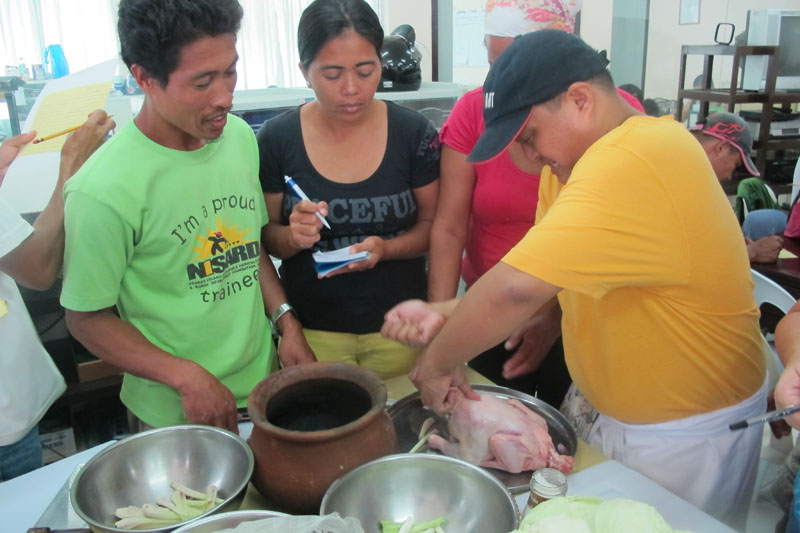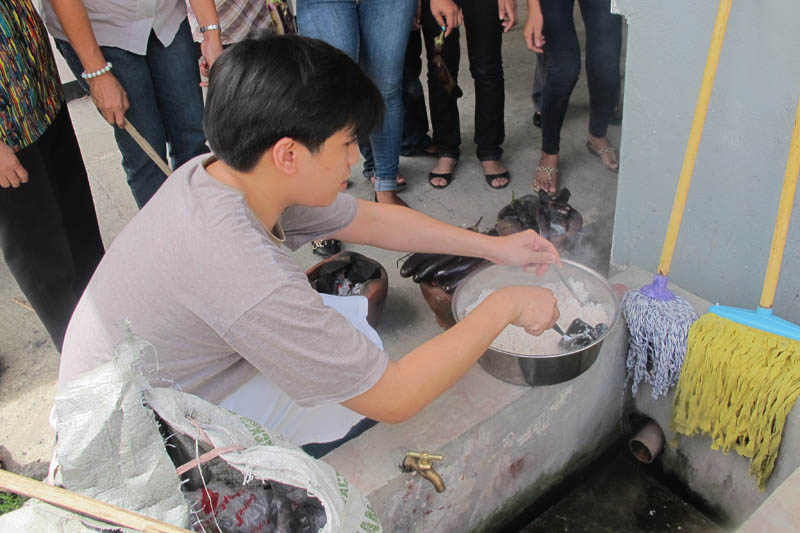Filtered By: Lifestyle
Lifestyle
Ang Sariling Atin community kitchen seeks to preserve true Pinoy cuisine
Text and Photos By LAUREL FANTAUZZO
Forget, for a moment, that Amy Besa’s Ang Sariling Atin Culinary Heritage Institute community kitchen is not open yet. Let’s take a tour anyway.
The kitchen is a white-walled, brown-roofed, medium-sized building, in a rural part of Dumaguete. It resembles in its compact liveability a clean and cozy family home, the kind of place where you might visit your hardworking, humble grandparents. As you stand outside, you’ll hear voices, water running, quick chopping—all signs of a happy industry.

Making a kinulob.
Step through the doorway. You’ll notice, first, the striking colors of the vegetables—vibrant, living shades of green, red, orange, white. No ingredient in this kitchen has traveled farther than a few kilometers to reach the cutting boards and counters. Some women squeeze fresh milk from green coconuts; others cut garlic, sort malunggay, clean fresh fish, shell fresh crabs, sprinkle sea salt. They have lively conversations as they work, blending their togetherness with the essential, collective act of preparing good food.
Educated by the Kawali Kings
The Ang Sariling Atin chefs and kitchen workers are mostly women from the nearby barangay Dauin, once riven with the familiar blights of malnutrition and unemployment. These women have skills now; they train each other, having been advised, first, by the Kawali Kings, an eager-to-help team of chefs from the Enderun Colleges of the Culinary Arts. The Kawali Kings have devoted their lives to the study and preparation of Filipino cuisine, and they have been happy to teach the women of Dauin to cultivate ingredients from their own backyards.
If you sense an inclination toward healthy habits here, your instincts would be correct. The community kitchen stands in the middle of the Silliman Marina Mission Clinic, a compound dedicated to addressing the medical concerns of neighboring barangays. The pursuit of holistic wellness is indeed at work, even here.
Affixed to one wall is a schedule of programs residents will attend. “Cooking for Wellness: Food as Medicine.” “How to Start a Container Garden.” “Kitchen Skills: Sanitary Preparation.”
While it functions as a hub for a low-income barangay, this kitchen works across the Filipino class divide. Wealthier patrons go visit for its Ang Sariling Atin seal, a guarantee of the entrees’ organic, local, untampered-with freshness. Chefs journey from upscale restaurants, wanting to stock their own kitchens for patrons who demand culinary excellence. Low-wealth residents attend its peer training programs to learn the finer points of maneuvering a kitchen.
But the kitchen’s heart is, of course, its food.
So tip your eyes toward a wide-mouthed, metal pot. Here is a pile of steamed red rice, layered with elegantly knotted green beans and sunny, orange squares of squash. Outside, resting over a small set of coals, is a red clay palayok covered with fresh banana leaves. Simmering inside is kinulob, a whole, organic chicken slow-cooked with ginger, garlic, spring onions, turmeric, and hand-squeezed coconut milk.
Cooking is an elemental act
This elemental act—the preparation, presentation, and eating of a good meal—is at the heart of Amy Besa’s vision for the Ang Sariling Atin movement. It's currently a dream in its planning stages but, eventually, she hopes, Ang Sariling Ating will franchise products and restaurants, beginning with this small kitchen, reconnecting Filipinos with the slow, careful processes of the dishes and culinary habits nearly lost to a generation.
If it sounds audacious to believe that Filipino food is the key to a healthier Philippines, you might want to listen to Amy Besa. She is a passionate evangelist and preservationist of Filipino food, as the co-founder of Purple Yam, the flagship Filipino restaurant of the United States. There, her husband Chef Romy Dorotan uses fresh and organic ingredients for everything from chicken adobo to durian ice cream.
“If you think Filipino food is unhealthy, you have no idea!” she says. Citizens may be suffering from obesity, malnutrition, and high blood pressure in the entire Asia-Pacific region, but the solution need not be medicinal, bland meals.
She continues: “When we say our food, it doesn’t just mean dishes—crispy pata, sisig. It means local ingredients, flavors, flavor profiles. Those flavor profiles come from cooking techniques, cooking equipment. Using leaves! Bamboo! The clay pot! "

Felix toasting the coconut.
“My conclusion is that culinary preservation equals health.”
To Besa, the solution to changing the health of a populace means returning to the past, and to the land.
“My prescription is that we go back to the food of our forefathers,” she explains. “All nutritionists are saying, now, to eat whole foods, not processed foods. That’s what our grandparents taught us.”
Negros is a chef's dream
Negros—the chosen province for Besa’s project, the Ang Sariling Atin Culinary Heritage Institute—is a careful chef’s dream, a wildly diverse producer of organic foods in the Philippines. With the partnership and encouragement of Siliman University in Dumaguete, entrepreneurs, and overseas communities in New York, Besa is laying the groundwork for the Ang Sariling Atin community kitchen, repeating her dream to anyone who might listen and collaborate.
Besa and the Kawali Kings chefs have already tried cooking workshops with the mothers of Dumaguete on healthy cooking and eating. The community gathered around pots of kinulob, vegetables, rice, and seafood in happy, proud amazement, eating portion after portion.
“The key to a healthy nation is preserving one's culinary heritage,” Besa says.
The Philippines’ historical food, prepared and enjoyed by generations past, is perhaps one active, living prescription for a proud and capable people. In Dumaguete, driven by Besa’s dream, Filipinos are ready to gather and prepare the feast. – KDM/HS, GMA News
The Philippines’ historical food, prepared and enjoyed by generations past, is perhaps one active, living prescription for a proud and capable people. In Dumaguete, driven by Besa’s dream, Filipinos are ready to gather and prepare the feast. – KDM/HS, GMA News
More Videos
Most Popular



